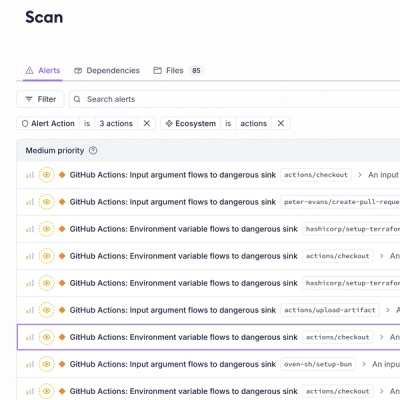
Product
Introducing Socket Firewall Enterprise: Flexible, Configurable Protection for Modern Package Ecosystems
Socket Firewall Enterprise is now available with flexible deployment, configurable policies, and expanded language support.
@graphistry/falcor
Advanced tools

This is the Graphistry fork of the FalcorJS client library. This library includes a number of bug fixes, performance improvements, and additional features, and will be actively maintained and developed.
get algorithm has been improved by ~100%.getVersion runtime is now O(1).branchSelector has been introduced to allow users to customize the results from get calls.recycleJSON flag has been introduced which instructs the Model to diff and recycle the output JSON Objects across get calls. This allows us to significantly improve performance for stable queries (see get performance numbers below).onChangesCompleted callback has been added to the API. This callback is similar to the existing onChange callback, except it's only called after all the operations that will change the cache have finished (this is more explicit than debouncing the onChange callback).falcor-http-datasource has been removed from the public browser build.get improvements to set.Get Tests:
@netflix/falcor getJSON - 100 paths from cache x 13,715 ops/sec ±16.34% (70 runs sampled) (0.42% of 1 frame @ 60FPS)
@graphistry/falcor getJSON - 100 paths from cache x 26,009 ops/sec ±3.15% (75 runs sampled) (0.24% of 1 frame @ 60FPS)
@graphistry/falcor getJSON - 100 paths from cache x 3,100,760 ops/sec ±10.00% (78 runs sampled) (0% of 1 frame @ 60FPS) (recycled JSON)
@netflix/falcor getJSONGraph - 100 paths from cache x 2,920 ops/sec ±2.10% (85 runs sampled) (2.04% of 1 frame @ 60FPS)
@graphistry/falcor getJSONGraph - 100 paths from cache x 2,516 ops/sec ±11.44% (67 runs sampled) (2.4% of 1 frame @ 60FPS)
@netflix/falcor getVersion x 2,178,625 ops/sec ±6.18% (70 runs sampled) (0% of 1 frame @ 60FPS)
@graphistry/falcor getVersion x 5,019,760 ops/sec ±5.46% (78 runs sampled) (0% of 1 frame @ 60FPS)
Set Tests:
@netflix/falcor setJSONGraph - 100 paths into cache x 5,800 ops/sec ±11.90% (77 runs sampled) (1.02% of 1 frame @ 60FPS)
@graphistry/falcor setJSONGraph - 100 paths into cache x 4,987 ops/sec ±10.68% (75 runs sampled) (1.2% of 1 frame @ 60FPS)
@netflix/falcor setPathMaps - 100 paths into cache x 4,331 ops/sec ±1.67% (80 runs sampled) (1.38% of 1 frame @ 60FPS)
@graphistry/falcor setPathMaps - 100 paths into cache x 3,852 ops/sec ±6.05% (76 runs sampled) (1.56% of 1 frame @ 60FPS)
@netflix/falcor setPathValues - 100 paths into cache x 2,354 ops/sec ±12.83% (68 runs sampled) (2.52% of 1 frame @ 60FPS)
@graphistry/falcor setPathValues - 100 paths into cache x 2,441 ops/sec ±9.82% (68 runs sampled) (2.46% of 1 frame @ 60FPS)
DataSource Tests:
@netflix/falcor getJSON - 50 of 100 paths from DataSource x 1,100 ops/sec ±2.03% (81 runs sampled) (5.46% of 1 frame @ 60FPS)
@graphistry/falcor getJSON - 50 of 100 paths from DataSource x 1,557 ops/sec ±6.89% (73 runs sampled) (3.84% of 1 frame @ 60FPS)
@graphistry/falcor getJSON - 50 of 100 paths from DataSource x 47,791 ops/sec ±7.21% (78 runs sampled) (0.12% of 1 frame @ 60FPS) (recycled JSON)
@netflix/falcor getJSONGraph - 50 of 100 paths from DataSource x 635 ops/sec ±8.75% (79 runs sampled) (9.42% of 1 frame @ 60FPS)
@graphistry/falcor getJSONGraph - 50 of 100 paths from DataSource x 614 ops/sec ±6.47% (73 runs sampled) (9.78% of 1 frame @ 60FPS)
You can check out a working example server for a Netflix-like application here right now. Alternately you can go through this barebones tutorial in which we use the Falcor Router to create a Virtual JSON resource. In this tutorial we will use Falcor's express middleware to serve the Virtual JSON resource on an application server at the URL /model.json. We will also host a static web page on the same server which retrieves data from the Virtual JSON resource.
In this example we will use the falcor Router to build a Virtual JSON resource on an app server and host it at /model.json. The JSON resource will contain the following contents:
{
"greeting": "Hello World"
}
Normally Routers retrieve the data for their Virtual JSON resource from backend datastores or other web services on-demand. However in this simple tutorial the Router will simply return static data for a single key.
First we create a folder for our application server.
mkdir falcor-app-server
cd falcor-app-server
npm init
Now we install the falcor Router.
npm install falcor-router --save
Then install express and falcor-express. Support for restify is also available, as is support for hapi via a third-party implementation.
npm install express --save
npm install falcor-express --save
Now we create an index.js file with the following contents:
// index.js
var falcorExpress = require('falcor-express');
var Router = require('falcor-router');
var express = require('express');
var app = express();
app.use('/model.json', falcorExpress.dataSourceRoute(function (req, res) {
// create a Virtual JSON resource with single key ("greeting")
return new Router([
{
// match a request for the key "greeting"
route: "greeting",
// respond with a PathValue with the value of "Hello World."
get: function() {
return {path:["greeting"], value: "Hello World"};
}
}
]);
}));
// serve static files from current directory
app.use(express.static(__dirname + '/'));
var server = app.listen(3000);
Now we run the server, which will listen on port 3000 for requests for /model.json.
node index.js
Now that we've built a simple virtual JSON document with a single read-only key "greeting", we will create a test web page and retrieve this key from the server.
Now create an index.html file with the following contents:
<!-- index.html -->
<html>
<head>
<!-- Do _not_ rely on this URL in production. Use only during development. -->
<script src="https://netflix.github.io/falcor/build/falcor.browser.js"></script>
<!-- For production use. -->
<!-- <script src="https://cdn.jsdelivr.net/falcor/{VERSION}/falcor.browser.min.js"></script> -->
<script>
var model = new falcor.Model({source: new falcor.HttpDataSource('/model.json') });
// retrieve the "greeting" key from the root of the Virtual JSON resource
model.
get("greeting").
then(function(response) {
document.write(response.json.greeting);
});
</script>
</head>
<body>
</body>
</html>
Now visit http://localhost:3000/index.html and you should see the message retrieved from the server:
Hello World
For detailed high-level documentation explaining the Model, the Router, and JSON Graph check out the Falcor website.
For API documentation, go here
For a working example of a Router, check out the falcor-router-demo.
For questions and discussion, use Stack Overflow.
FAQs
A JavaScript library for efficient data fetching.
The npm package @graphistry/falcor receives a total of 2,365 weekly downloads. As such, @graphistry/falcor popularity was classified as popular.
We found that @graphistry/falcor demonstrated a not healthy version release cadence and project activity because the last version was released a year ago. It has 2 open source maintainers collaborating on the project.
Did you know?

Socket for GitHub automatically highlights issues in each pull request and monitors the health of all your open source dependencies. Discover the contents of your packages and block harmful activity before you install or update your dependencies.

Product
Socket Firewall Enterprise is now available with flexible deployment, configurable policies, and expanded language support.

Security News
Open source dashboard CNAPulse tracks CVE Numbering Authorities’ publishing activity, highlighting trends and transparency across the CVE ecosystem.

Product
Detect malware, unsafe data flows, and license issues in GitHub Actions with Socket’s new workflow scanning support.